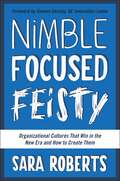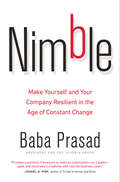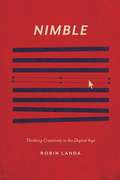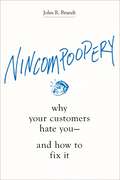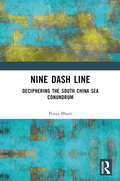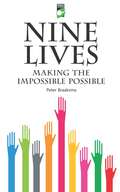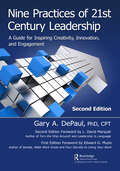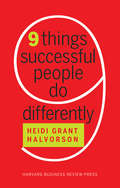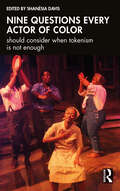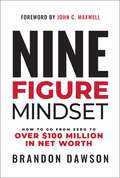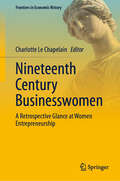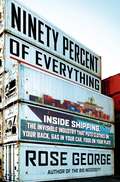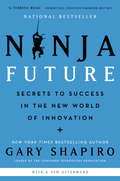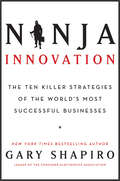- Table View
- List View
Nike in China
by James E. Austin Francis J. AguilarNike is reviewing its strategy for producing shoes in China for the U.S. market. Compares the experience in China with that in other countries.
Nike in Transition (A): The Ascendancy of Bob Woodell
by Christopher A. Bartlett Robert W. LightfootExplores Bob Woodell's tenure as Nike's first COO. Describes development of Woodell's management style, his attempts to develop the organization, and his responses to unforeseen business problems. Changing market forces, new competitors, a build-up of low-end inventory, and the absence of Phil Knight, the company's founder, in daily operations, make this a difficult time for Nike. Against the backdrop of disappointing financial results and an upcoming shareholders' meeting, students are asked to assess Woodell's performance, whether management is truly in control of the organization and the company's business, and what role Knight should be playing in the organization.
Nike in Transition (B): Phil Knight Returns
by Christopher A. Bartlett Robert W. LightfootAfter returning to the CEO/COO job, Phil Knight makes changes to Nike's strategy, organization, and management between 1983 and 1987 aimed at making Nike more responsive to the market place. He takes cost-cutting measures, and experiments with several management and organizational changes. After much strife within the company, Knight ends up with a hybrid matrix, a new group of managers, and a new strategy. Has Knight made the right choices? Has he squashed Nike's entrepreneurial culture? Is Nike poised for recovery?
Nike, Inc.: Entering the Millennium
by William E. FruhanTraces the evolution of Nike from 1987 through 1998. Through a series of eight assignment questions, it examines how the company has created and sustained a competitive advantage, and how that competitive advantage is reflected in growth, profitability, and share price performance.
Nike: Changing the Sneakers Game
by Anita Elberse Howard Johnson Bryce Aiken"Our goal is to be the kind of start-up that would terrify Nike-if Nike didn't already own us." Ron Faris, general manager of S23NYC, a Manhattan-based digital studio owned by sports apparel giant Nike, is on the phone with Adam Sussman, Nike's chief digital officer. It is June 1, 2018. Two years earlier, Sussman was behind Nike's push to acquire Virgin Mega, a startup comprised of Faris and his small team, which has since morphed into a studio that plays a pivotal role in Nike's digital strategy. With the studio's mobile app, SNKRS (pronounced 'sneakers'), specifically, Nike seeks to strengthen its connection with the most fanatical of its fans-the sneakerheads-and "bring back the fun and emotion of buying," as Sussman put it. Is Nike on the right path with its digital strategy and, in particular, with how it seeks to change the sneakers game and compete with rivals such as Adidas and Puma? Does it make sense for the company to pursue the kinds of innovations featured in the SNKRS app? And what kind of campaigns and activations should it prioritize in the future?
Nikkei 225 Reconstitution
by Robin GreenwoodTaka Haneda, a proprietary trader at the Tokyo office of Goldman Sachs, has just learned that the Nikkei 225 will undergo a significant redefinition over the coming week. He faces several billion dollars of customer orders, as well as the opportunity to commit the firm's capital to provide liquidity for the event. He must decide what positions to establish, and at what price he is willing to get out.
Nile Water Conflict and the Grand Ethiopian Renaissance Dam (Springer Geography)
by Wossenu AbtewThe book follows on from “The Grand Ethiopian Renaissance Dam on the Blue Nile” GERD. It will have a good background introduction on the Nile basin. The value of Nile water will be presented in view of the global water stress facing mankind and the region. International importance of Nile waters will be presented with food insecurity of regions outside the basin. Food and energy demand in the upper basin and potential upstream irrigation demand on Nile waters will be presented. Analysis of the GERD three years of filling, remaining filling years, and modes of operation will be presented along with the water conflict. Climate change and climate variation (droughts and floods) impacts on the water control of 56 percent of the Nile flow (the Blue Nile and the GERD), and ensuing water war require analysis and publication. One of the major features of the Nile is the Sudd marshes in South Sudan. The importance of wetlands in the hydroclimate of the Nile basin and the merit and demerits of draining the Sudd, to get more water on the short term, will be presented. The Everglades in the United States will be presented as a global experience in regional wetland drainage and its impact on regional hydroclimate.
Nimble, Focused, Feisty: Organizational Cultures That Win in the New Era and How to Create Them
by Sara RobertsLeaders have talked about the importance of corporate culture for decades, but the success of iconic companies like GE, Apple, and Google shows how culture is a strategic lever that can be utilized for driving growth, change, and innovation. In this new age of globalization, rapid technology shifts, and constant disruption, the 21st century marketplace is more volatile and uncertain than ever. To thrive, businesses need a new kind of emphasis around culture. Sara Roberts, former CEO and founder of Roberts Golden and a seasoned executive consultant to dozens of Fortune 500 companies and CEOs, sees how flourishing companies—from established market leaders to the surprising upstarts—share three distinct attributes: Nimble: They are much faster and more agile than ordinary organizations Focused: They use their sense of purpose as a lens to understand and meet the needs of customers and markets Feisty: They play big and act bold to capitalize on advantages and out-muscle the competition For successful companies in this new era, culture is not about playing defense but about going on offense. It's purposely designed, leveraged, and honed to deliver value and drive growth. In Nimble, Focused, Feisty, Roberts provides not only a look into what these organizations are doing differently but also a blueprint and framework so your company can create a cultural strategy to thrive in the new era.
Nimble: Make Yourself and Your Company Resilient in the Age of Constant Change
by Baba Prasad"Nimble shows how we can anticipate and adapt to an increasingly chaotic world--and become better leaders, strategists, and innovators along the way."--Adam Grant, bestselling author of OriginalsCutting-edge insights for succeeding in times of chaotic changeToday's world is best described by one word: turbulence. Every leader today knows they need to be nimble, agile and resilient--but how? In this engaging and insightful new book, management strategist and Wharton Fellow Baba Prasad sheds new light on the subject, and offers practical advice for executives, entrepreneurs, and anyone else who'll need the skills to face the unpredictability, risk, and deep uncertainty that lies ahead.Filled with vivid examples and insights from around the world and throughout history - from the Brazilian rainforest and the "frugal innovation" of 19th century Indian engineers to Ericsson, Lego, Burt's Bees, and Zara--Nimble reveals what sets the most nimble leaders and organizations apart from the competition, presenting five types of agility that help individuals and companies not just survive but thrive in times of great change:Analytical agility: Understanding the real problemOperational agility: Driving leadership through actionInnovative agility: Finding creative solutions when you need them mostCommunicative agility: Solving problems togetherVisionary agility: Going beyond the here and nowIt is possible to embrace change and uncertainty without sacrificing innovation and growth. Nimble shows you how.
Nimble: Thinking Creatively in the Digital Age
by Robin LandaIn graphic design, creative thinking skills are undoubtedly important, but sometimes the importance of critical thinking skills is overlooked.Nimble will help you discover how to develop a creativity that is strategic and also able to cross platforms, industries or sectors. You'll discover a creative thinking process that allows you to generate scalable ideas that are both sticky and stretchy.As you develop a ?exible mind that is ideal for visual communication, digital marketing, or social media, you&’ll increase your value as a designer - to your clients, your employer, or simply your own work.
Nimbus Therapeutics
by Peter Barrett Karim R. Lakhani Julia KelleyThis case focuses on Nimbus Therapeutics, a biotechnology startup based in Cambridge, Massachusetts, as its leadership team tries to determine the company's long-term strategy. The startup's founders structured Nimbus as a limited liability company, which has given it more flexibility when it comes to funding and development partnerships. Does the operating structure still makes sense as Nimbus looks ahead to the future?
Nincompoopery: Why Your Customers Hate You--and How to Fix It
by John R. BrandtFind and kill the corporate stupidity that drives customers crazy. CEO and award-winning business writer John R. Brandt offers concrete examples of how any organization--large or small, and regardless of industry--can innovate in ways that delight customers and attract top-level talent.Nincompoopery--terrible customer service, idiotic business processes, and soul-crushing management practices--surrounds all of us. We lose time, patience, and profits as stuck-in-the-past organizations actively prevent us (and our customers) from getting the value we (and they) deserve. Can’t anybody change this? CEO and award-winning business writer John R. Brandt says we can. In Nincompoopery: Why Your Customers Hate You--And How to Fix It, he leverages research across thousands of companies to show leaders how to find and kill the corporate stupidity that drives customers crazy. More importantly, he offers concrete examples of how any organization--large or small, and regardless of industry--can innovate in ways that delight customers and attract top-level talent.Brandt has worked with hundreds of companies to help them outwit competitors, and in the blunt (and funny) Nincompoopery, he shares his unique blueprint for success. It usually starts by asking a simple question or two, such asWhy should our customers have to rekey their data multiple times to make a single purchase?Why are there four levels of approval just to order basic supplies?Why can’t we get qualified candidates for open positions, or provide new employees with decent training?In short: How did we become such nincompoops? And when will we stop? Nincompoopery offers leaders the answers they need--and the profits they crave--with a scoop of humor on the side. Enjoy!
Nine Dash Line: Deciphering the South China Sea Conundrum
by Pooja BhattThe South China Sea (SCS) has been in the spotlight since the Permanent Court of Arbitration's ruling in 2016, favouring the Philippines on its maritime entitlements. China rejected the verdict and militarized the islands while asserting its 'historic rights' over more than 80% of the SCS. This book examines China's behaviour in the SCS from multiple perspectives like history, environment, law, trade, security, and its relations with Southeast Asian countries that have their own EEZ claims in the SCS, revealing that their actions align with their grand strategy of becoming a global and maritime superpower by 2050 with the Nine Dash Line at its centre.Print edition not for sale in South Asia (India, Sri Lanka, Nepal, Bangladesh, Pakistan and Bhutan)
Nine Lives
by Peter Braaksma"You can cut the flower, but you cannot stop the coming of spring." Malalai Joya, the young member of the Afghan parliament, refuses to let injustice go unchallenged. Her words reflect the irrepressible attitudes and actions of all the women and men who tell their stories here.As with all the titles in New Internationalist's World Changing imprint, Nine Lives sees opportunity in the midst of adversity and presents the life stories of people who have been confronted with seemingly insurmountable obstacles, opposition, and oppression.Whether it is human rights activist Harry Wu, who spent nineteen years in Chinese labor camps, or Nobel Laureate and President of Costa Rica Oscar Arias Sánchez, each of the nine voices in this collection has confronted an urgent and inescapable need to dig deep, either to rescue themselves or to forge a fresh way forward for others.To understand the key stories behind the headlines, Peter Braaksma believes that it is essential to feel the personal, intimate experience of people working on the frontline of human rights and humanitarian issues; that the stories, uninterrupted and unpolished, must speak for themselves.Reading like nine mini-novels, the nine remarkable stories belong to Bassam Aramin (Palestinian National Authority), Monireh Baradaran (Iran), Youk Chhang (Cambodia), Sompop Jantraka (Thailand), Malalai Joya (Afghanistan), Chaeli Mycroft (South Africa), Oscar Arias Sánchez (Costa Rica), and Harry Wu (China).Peter Braaksma has worked as an editor, communications advisor, and journalist in the Netherlands and the United Kingdom.
Nine Lives of Neoliberalism
by Philip Mirowski Quinn Slobodian Dieter PlehweUntangling the long history of Neoliberalism is dead. Again. Yet the philosophy of the free market and the strong state has an uncanny capacity to survive, and even thrive, in times of crisis. Understanding neoliberalism’s longevity and its latest permutation requires a more detailed understanding of its origins and development. This volume breaks with the caricature of neoliberalism as a simple, unvariegated belief in market fundamentalism and homo economicus. It shows how neoliberal thinkers perceived institutions from the family to the university, disagreed over issues from intellectual property rights and human behavior to social complexity and monetary order, and sought to win consent for their project through the creation of new honors, disciples, and networks. Far from a monolith, neoliberal thought is fractured and, occasionally, even at war with itself. We can begin to make sense of neoliberalism’s nine lives only by understanding its own tangled and complex history.
Nine Practices of 21st Century Leadership: A Guide for Inspiring Creativity, Innovation, and Engagement
by Gary A. DePaulNear the end of the 20th Century, the leadership concept radically evolved away from the traditional concept of accomplishing work through others. Unfortunately, too many professionals unconsciously still have faulty traditional assumptions that can get them, their teams, and their organizations in trouble. The author has researched the evolution of leadership and summarizes seven contemporary principles, twenty-six underlying leadership beliefs, and nine crucial practices of 21st Century Leadership. While too many leadership books focus on qualities, DePaul explains specific behaviors for practicing leadership. The second edition includes new research about leadership and leadership development. With the pandemic, organizations have had to rely more on effective leadership to build high-performing teams, often at a distance. Training departments have had to radically update how they develop employees at all levels, and executive coaches have transitioned to virtual client support. With all these environmental changes as well as new social pressures on organizations to embrace diversity, equity, and inclusion, organizations need to change how they lead and avoid allowing their culture to develop by chance.
Nine Things Successful People Do Differently
by Heidi Grant HalvorsonAre you at the top of your game-or still trying to get there?Take your cues from the short, powerful 9 Things Successful People Do Differently, where the strategies and goals of the world's most successful people are on display-backed by research that shows exactly what has the biggest impact on performance. Here's a hint: accomplished people reach their goals because of what they do, not just who they are.Readers have called this "a gem of a book." Get ready to accomplish your goals at last.
Nine questions every actor of color should consider when tokenism is not enough
by Shanésia DavisThis book confronts and analyzes the systemic racism that confronts actors of color in the USA through interviews with leading performers in the nation’s theatrical epicentre of Chicago.Each chapter deals with a different central question, from how these actors approach roles and the obstacles that they face, to the ways in which the industry can change to better enable actors of color. By bringing together these actors and sharing the ways in which they have functioned within the white theatre world, we can appreciate how theatre needs to embrace their identities so that all voices are heard, understood, and valued. The stories of these actors will reflect the systemic racism of the past and present with the hope of remaking the future.This is an important book for students, teachers, and professionals who engage in theatre work, helping them to understand the lived experiences of actors of color through those actors’ own words.
Nine to Five
by Joanna L. GrossmanNine to Five provides a lively and accessible introduction to the laws and policies regulating sex, sexuality, and gender identity in the American workplace. Contemporary cases and events reveal the breadth and persistence of sexism and gender stereotyping. Through a series of essays organized around sex discrimination, sexual harassment, pregnancy discrimination, and pay equity, the book highlights legal rules and doctrines that privilege men over women and masculinity over femininity. In understanding the law - what it forbids, what it allows, and to what it turns a blind eye - we see why it is far too soon to declare the triumph of working women's equality. Despite significant gains for women, gender continues to define the work experience in both predictable and surprising ways. A witty and engaging guide to the legal terrain, Nine to Five also proposes solutions to the many obstacles that remain on the path to equality.
Nine-Figure Mindset: How to Go from Zero to Over $100 Million in Net Worth
by Brandon DawsonBehind the life you want to live lies the power you already have to create it. In Nine-Figure Mindset, Brandon Dawson unveils how to tap into the remarkable potential hidden inside each and every one of us. Drawing from his own awe-inspiring journey, Brandon shows that success and leadership are attainable to anyone willing to cultivate the right shift in thinking. Combining personal experiences with actionable strategies, Nine-Figure Mindset serves as a guidebook to next level achievements you&’ve never imagined were possible. Brandon Dawson, a very accomplished business icon, shares his wealth of wisdom, earned from his humble beginnings to achieving a record breaking exit having sold his last business for $151 million. Are you an entrepreneur with a gleam in your eye but the feeling that you&’re running in mud? Do you sense that with the right team in place, you could achieve so much more? Perhaps you&’re already successful with an undeniable hunger for more? The question is not whether you are striving hard enough but whether you&’re striving for enough and in the right direction. Dawson&’s secrets to starting, scaling, and above all leading a positive, independent business will help you cultivate exactly what&’s needed to attract exceptional individuals and seize extraordinary opportunities. Discover how tiny shifts in perspective can change everything.Chances are, you already have everything you need to succeed—you just need someone who&’s been there to show you the way. Nine-Figure Mindset is your opportunity to grab a front row seat for your business and gain the capabilities to where you want to go. Your dreams are not only possible, they should be your priority—and, by the way, they might not be big enough.
Nineteenth Century Businesswomen: A Retrospective Glance at Women Entrepreneurship (Frontiers in Economic History)
by Charlotte Le ChapelainThe book examines female entrepreneurship in the nineteenth century. Economic history has long accorded women entrepreneurs a very minor place, relegating them to the status of historical anecdotes. The hypothesis of women’s withdrawal from the business sphere after the eighteenth century has long dominated. However, this view has recently been subject to a fundamental questioning. Women did in fact actively contribute to economic development by occupying key positions in the business sphere as independent workers, investors and entrepreneurs. Businesswomen were no exception in the nineteenth century. They ran businesses of all sizes and in a wide range of industrial sectors. This book helps to bring nineteenth-century women entrepreneurs out of invisibility, by examining their entrepreneurial practices and shedding light on the role of the legal framework in which they operated. This interdisciplinary book will appeal to students, scholars, and researchers of economic history, business history, history of law, and economics and management sciences in general, interested in a better understanding of female entrepreneurship in the nineteenth century.
Ninety Percent of Everything: Inside Shipping, the Invisible Industry that Puts Clothes on Your Back, Gas in Your Car, and Food on Your Plate
by Rose GeorgeEye-opening and compelling, the overlooked world of freight shipping, revealed as the foundation of our civilization On ship-tracking websites, the waters are black with dots. Each dot is a ship; each ship is laden with boxes; each box is laden with goods. In postindustrial economies, we no longer produce but buy. We buy, so we must ship. Without shipping there would be no clothes, food, paper, or fuel. Without all those dots, the world would not work. Freight shipping has been no less revolutionary than the printing press or the Internet, yet it is all but invisible. Away from public scrutiny, shipping revels in suspect practices, dubious operators, and a shady system of “flags of convenience.” Infesting our waters, poisoning our air, and a prime culprit of acoustic pollution, shipping is environmentally indefensible. And then there are the pirates. Rose George, acclaimed chronicler of what we would rather ignore, sails from Rotterdam to Suez to Singapore on ships the length of football fields and the height of Niagara Falls; she patrols the Indian Ocean with an anti-piracy task force; she joins seafaring chaplains, and investigates the harm that ships inflict on endangered whales. Sharply informative and entertaining, Ninety Percent of Everything reveals the workings and perils of an unseen world that holds the key to our economy, our environment, and our very civilization.
Ninja Future: Secrets to Success in the New World of Innovation
by Gary ShapiroNinja Future is an essential read for businesses and individuals striving to remain competitive in a rapidly evolving world: Gary Shapiro, the president and CEO of the Consumer Technology Association, casts his eye toward the future, charting how the innovative technologies of today will transform not only the way business is done but society itselfDuring his more than three decades at the head of the Consumer Technology Association, Gary Shapiro has witnessed, and been a part of, one of the most extraordinary periods of technological change in human history. Today’s world is almost unrecognizable from that of just a decade or two before: in just a few short years, the internet has already transformed how we access information, purchase goods, get from place to place, and do our jobs. And even greater changes are on the horizon. In Ninja Future, Shapiro explains the evolving technological landscape, breakthroughs underway now and those we can only envision. New innovations such as self-driving vehicles, blockchain, 5G, the Internet of Things, and countless others will forever change the economy as we know it. Shapiro uses case studies to identify companies and countries addressing today’s challenges particularly well—and relates lessons from those that have stumbled. Drawing on the insights he has gleaned as a martial arts black belt, he shows how businesses can move to succeed in today’s turbulent environment by adopting the mindset of “ninjas”—adapting to technological change to capitalize on opportunities at lightning speed.
Ninja Innovation: The Ten Killer Strategies of the World's Most Successful Businesses
by Gary ShapiroInnovate or dieFor thirty years, Gary Shapiro has observed the world's most innovative businesses from his front-row seat as leader of the Consumer Electronics Association. Now he reveals the ten secrets of "ninja innovators" like Apple, Amazon, Google, Microsoft, and many others.What does it take to succeed? Discipline. Mission-oriented strategy. Adaptability. Decisiveness. And a will for victory. In short, today's most successful businesses are "ninja innovators." Drawn from Gary Shapiro's three decades of experience leading the consumer electronics industry, Ninja Innovation takes readers behind the scenes of today's top enterprises, uncovering their ten essential strategies for success.As head of the Consumer Electronics Association and its influential annual trade show, the International CES, Shapiro has worked with the most innovative companies in history—Intel, IBM, and Samsung, to name a few—focusing on creating policies and events that produce revolutionary products year after year. He has learned the key strategies that have guided these businesses to record-breaking profits, as well as the traps that have led so many others to crushing failure. In order to stay in front of the pace of innovation, Shapiro observes, top companies must operate as an elite strike force—just like the legendary medieval warriors known as ninjas. Ninjas weren't called upon to do the ordinary; they had to perform truly extraordinary tasks, while risking everything. As a highly trained martial-arts black belt himself, Shapiro mines the valuable insights of these centuries-old warriors to spotlight the secrets of agility, creativity, decisiveness, and reinvention that are essential for twenty-first-century leaders seeking breakthrough success. Taking readers inside the most cutting-edge businesses, Ninja Innovation is the ultimate guide to achieving victory in today's innovate-or-die economy.
Nintendo Magic: Winning the Videogame Wars
by Osamu InoueBack in the 80s, Nintendo ruled the home-entertainment market with the NES (Nintendo Entertainment System). But then rival Sony introduced PlayStation, which featured advancements and cutting-edge technology that put Nintendo's Super-NES to shame. Nintendo quickly lost its dominant market share to Sony and found itself floundering. In 2006, Nintendo released Wii at the same time Sony introduced its highly-anticipated and much-vaunted PlayStation III and Microsoft's XBox 360. Wii's David defeated PlayStation's Goliath, inversely echoing the SNES/PlayStation outcome of a decade previous. Nintendo Magic: Winning the Videogame Wars is the story of what went right, discussing the business strategies and marketing savvy that took on the mighty Sony and won.Topics include:How where you put your company is just as important as how you run it: being in KyotoFrom work force to policies, why Nintendo's "just enough" attitude succeedsWhy the ability to read a balance sheet is overratedRespect seniority but approve huge R&D budgets for talented junior employeesAllowing maximum communication between disparate divisions (hardware and software)Enlarging the pie: going after casual gamers (The art of mainstreaming)How the Wii will be the next major household appliance and the DSi will be the cell phone of the future.Nintendo Magic: Winning the Videogame Wars should serve as a warning to similar powerhouse industries never to understimate the modest competitor. It should occupy the bookshelf of any business person smart enough to know they don't need to be a giant to win.


